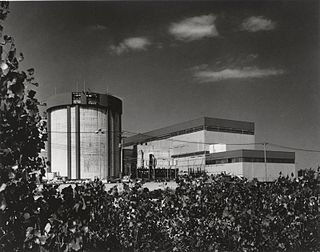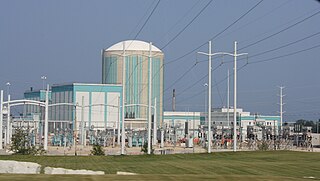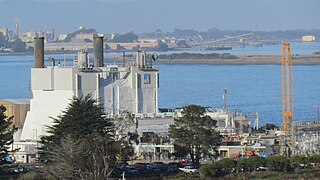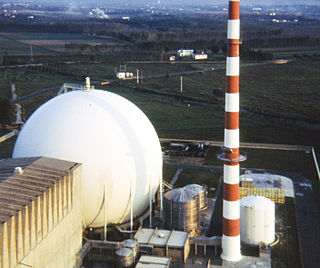
A nuclear reactor is a device used to initiate and control a fission nuclear chain reaction or nuclear fusion reactions. Nuclear reactors are used at nuclear power plants for electricity generation and in nuclear marine propulsion. Heat from nuclear fission is passed to a working fluid, which in turn runs through steam turbines. These either drive a ship's propellers or turn electrical generators' shafts. Nuclear generated steam in principle can be used for industrial process heat or for district heating. Some reactors are used to produce isotopes for medical and industrial use, or for production of weapons-grade plutonium. As of 2022, the International Atomic Energy Agency reports there are 422 nuclear power reactors and 223 nuclear research reactors in operation around the world.

A boiling water reactor (BWR) is a type of light water nuclear reactor used for the generation of electrical power. It is the second most common type of electricity-generating nuclear reactor after the pressurized water reactor (PWR), which is also a type of light water nuclear reactor.

A nuclear power plant (NPP) or atomic power station (APS) is a thermal power station in which the heat source is a nuclear reactor. As is typical of thermal power stations, heat is used to generate steam that drives a steam turbine connected to a generator that produces electricity. As of September 2023, the International Atomic Energy Agency reported there were 410 nuclear power reactors in operation in 32 countries around the world, and 57 nuclear power reactors under construction.

Pilgrim Nuclear Power Station (PNPS) is a closed nuclear power plant in Massachusetts in the Manomet section of Plymouth on Cape Cod Bay, south of the tip of Rocky Point and north of Priscilla Beach. Like many similar plants, it was constructed by Bechtel, and was powered by a General Electric BWR 3 boiling water reactor inside of a Mark 1 pressure suppression type containment and generator. With a 690 MWe production capacity, it produced about 14% of the electricity generated in Massachusetts.
The Monticello Nuclear Generating Plant is a nuclear power plant located in Monticello, Minnesota, along the Mississippi River. The site, which began operating in 1971, has a single nuclear reactor of the General Electric BWR-3 design generating 671 MWe. The plant is owned by Xcel Energy and operated by Northern States Power, its regional subsidiary.

Zion Nuclear Power Station was the third dual-reactor nuclear power plant in the Commonwealth Edison (ComEd) network and served Chicago and the northern quarter of Illinois. The plant was built in 1973, and the first unit started producing power in December 1973. The second unit came online in September 1974. This power generating station is located on 257 acres (104 ha) of Lake Michigan shoreline, in the city of Zion, Lake County, Illinois. It is approximately 40 direct-line miles north of Chicago, Illinois and 42 miles (68 km) south of Milwaukee, Wisconsin.

The Vallecitos Nuclear Center is a nuclear research facility, and the site of a former GE Hitachi Nuclear Energy electricity-generating nuclear power plant in unincorporated Alameda County, California, United States. The facility is approximately 30 miles (48 km) east of San Francisco, under jurisdiction of the US Nuclear Regulatory Commission's Region IV.

The Enrico Fermi Nuclear Generating Station is a nuclear power plant on the shore of Lake Erie near Monroe, in Frenchtown Charter Township, Michigan on approximately 1,000 acres (400 ha). All units of the plant are operated by the DTE Energy Electric Company and owned by parent company DTE Energy. It is approximately halfway between Detroit, Michigan, and Toledo, Ohio. It is also visible from parts of Amherstburg and Colchester, Ontario as well as on the shore of Lake Erie in Ottawa County, Ohio. Two units have been constructed on this site. The first unit's construction started on August 4, 1956 and reached initial criticality on August 23, 1963, and the second unit received its construction permit on September 26, 1972. It reached criticality on June 21, 1985 and was declared commercial on November 18, 1988. The plant is connected to two single-circuit 345 kV Transmission Lines and three 120 kV lines. They are operated and maintained by ITC Transmission.

The Kewaunee Power Station is a decommissioned nuclear power plant, located on a 900 acres (360 ha) plot in the town of Carlton, Wisconsin, 27 miles (43 km) southeast of Green Bay, Wisconsin in Kewaunee County, and south of the city of Kewaunee.
The electricity sector in Sweden has three operational nuclear power plants with 6 operational nuclear reactors, which produce about 29.8% of the country's electricity. The nation's largest power station, Forsmark Nuclear Power Plant, has three reactors producing 3.3 GW and 14% of Sweden's electricity.

Yankee Rowe Nuclear Power Station was a nuclear power plant in Rowe, Massachusetts, located on the Deerfield River in the town of Rowe in western Massachusetts. Its 180 MWe pressurized water reactor operated from 1961 to 1991. It produced electricity for New England consumers. The site is referred to as "Yankee-Rowe" or simply "Rowe", to avoid confusion with Vermont Yankee, another nuclear power station located in nearby Vernon, Vermont. The decommissioning of the site was completed in 2007.
Nuclear decommissioning is the process leading to the irreversible complete or partial closure of a nuclear facility, usually a nuclear reactor, with the ultimate aim at termination of the operating licence. The process usually runs according to a decommissioning plan, including the whole or partial dismantling and decontamination of the facility, ideally resulting in restoration of the environment up to greenfield status. The decommissioning plan is fulfilled when the approved end state of the facility has been reached.

Dodewaard nuclear power plant was a nuclear power plant with a 55 MWe boiling water reactor (BWR) of General Electric in the Dutch town of Dodewaard. The plant halted energy production in 1997. Its final decommissioning has been postponed for a period of 40 years and the plant was placed into a safe enclosure configuration in 2005.

Nuclear safety in the United States is governed by federal regulations issued by the Nuclear Regulatory Commission (NRC). The NRC regulates all nuclear plants and materials in the United States except for nuclear plants and materials controlled by the U.S. government, as well those powering naval vessels.

The Humboldt Bay Power Plant, Unit 3 was a 63 MWe nuclear boiling water reactor, owned by Pacific Gas and Electric Company that operated from August 1963 to July 1976 just south of Eureka, California.
Nuclear entombment is a method of nuclear decommissioning in which radioactive contaminants are encased in a structurally long-lived material, such as concrete. This prevents radioactive material and other contaminated substances from being exposed to human activity and the environment. Entombment is usually applied to nuclear reactors, but also some nuclear test sites. Nuclear entombment is the least used of three methods for decommissioning nuclear power plants, the others being dismantling and deferred dismantling. The use of nuclear entombment is more practical for larger nuclear power plants that are in need of both long and short term burials, as well as for power plants which seek to terminate their facility licenses. Entombment is used on a case-by-case basis because of its major commitment with years of surveillance and complexity until the radioactivity is no longer a major concern, permitting decommissioning and ultimate unrestricted release of the property. Considerations such as financial backing and the availability of technical know-how are also major factors.

Garigliano Nuclear Power Plant was a nuclear power plant located at Sessa Aurunca (Campania), in southern Italy. It was named after the river Garigliano.

The Boiling Nuclear Superheater (BONUS) Reactor Facility, also known to the locals as "Domes", or formally as Museo Tecnologico BONUS Dr. Modesto Iriarte, is a decommissioned nuclear power plant in Rincón, Puerto Rico. It was listed on the U.S. National Register of Historic Places in 2007.

Small modular reactors (SMRs) are a class of small nuclear fission reactors, designed to be built in a factory, shipped to operational sites for installation and then used to power buildings or other commercial operations. The first commercial SMR was invented by a team of nuclear scientists at Oregon State University (OSU) in 2007. Working with OSU's prototype, NuScale Power developed the first working model, available to the US market, in 2022. The term SMR refers to the size, capacity and modular construction. Reactor type and the nuclear processes may vary. Of the many SMR designs, the pressurized water reactor (PWR) is the most common. However, recently proposed SMR designs include: generation IV, thermal-neutron reactors, fast-neutron reactors, molten salt, and gas-cooled reactor models.
GE Hitachi Nuclear Energy (GEH) is a provider of advanced reactors and nuclear services. It is headquartered in Wilmington, North Carolina, United States. Established in June 2007, GEH is a nuclear alliance created by General Electric and Hitachi. In Japan, the alliance is Hitachi-GE Nuclear Energy. In November 2015, Jay Wileman was appointed CEO.


















